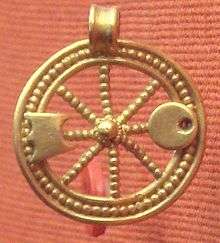Taranis
In Celtic mythology, Taranis is the god of thunder, who was worshipped primarily in Gaul, Gallaecia, Britain, and Ireland but also in the Rhineland and Danube regions, amongst others. Taranis, along with Esus and Toutatis as part of a sacred triad, was mentioned by the Roman poet Lucan in his epic poem Pharsalia as a Celtic deity to whom human sacrificial offerings were made.[1] Taranis was associated, as was the Cyclops Brontes ("thunder") in Greek mythology, with the wheel.


Many representations of a bearded god with a thunderbolt in one hand and a wheel in the other have been recovered from Gaul, where this deity apparently came to be syncretised with Jupiter.[2]
The name as recorded by Lucan is unattested epigraphically, but variants of the name include the forms Tanarus, Taranucno-, Taranuo-, and Taraino-.[3][4] The name is continued in Irish as Tuireann, and is likely connected with those of Germanic (Norse Thor, Anglo-Saxon Þunor, German Donar), Latvian (Pērkons), Lithuanian (Perkūnas), Greek (Zeus), Slavic (Perun), and Sami (Horagalles) gods of thunder. Taranis is likely associated with the Gallic Ambisagrus (likely from Proto-Celtic *ambi-sagros = "about-strength"), and in the interpretatio romana with Jupiter.
Etymology
The reconstructed Proto-Celtic form of the name is *Torano- ("thunder"), ultimately from the Proto-Indo-European root *(s)tenh₂- ("thunder"). Cognates are found in other Celtic languages: Old Irish torann, "thunder, noise" ; Breton taran ; Welsh taran, "(peal of) thunder, thunderclap"; see also proto-Germanic *þunraz (ONor. Thor, OHG Donar, Eng. thunder), Skt stanati and Lat. tono.[5][6] The Thracian deity Zbelthurdos could also be a cognate (from Thracian thurd(a), "to push, crash down").[7]
Association with the wheel

The wheel, more specifically the chariot wheel with six or eight spokes, was an important symbol in historical Celtic polytheism, apparently associated with a specific god, known as the wheel-god, identified as the sky- sun- or thunder-god, whose name is attested as Taranis by Lucan.[8] Numerous Celtic coins also depict such a wheel. The half-wheel shown in the Gundestrup cauldron "broken wheel" panel also has eight visible spokes.
Symbolic votive wheels were offered at shrines (such as in Alesia), cast in rivers (such as the Seine), buried in tombs or worn as amulets since the Middle Bronze Age.[9] Such "wheel pendants" from the Bronze Age usually had four spokes, and are commonly identified as solar symbols or "sun cross". Artefacts parallel to the Celtic votive wheels or wheel-pendants are the so-called Zierscheiben in a Germanic context. The identification of the Sun with a wheel, or a chariot, has parallels in Germanic, Greek and Vedic mythology (see sun chariot).

 Golden Celtic wheel with symbols, Balesme, Haute-Marne. Musée d'Archéologie Nationale.
Golden Celtic wheel with symbols, Balesme, Haute-Marne. Musée d'Archéologie Nationale.
Later cultural references
In 2013 a British combat drone system developed by defence contractor BAE Systems was named Taranis in reference to the Celtic god.[11]
Taranis and Toutatis are often mentioned by characters of the Asterix series.[12]
Footnotes
- M. Annaeus Lucanus. Pharsalia, Book I Archived 2006-05-02 at the Wayback Machine
- Paul-Marie Duval. 2002. Les Dieux de la Gaule. Paris, Éditions Payot.
- Nicole Jufer & Thierry Luginbühl. 2001. Répertoire des dieux gaulois. Paris, Éditions Errance.
- Jacob Grimm, Teutonic Mythology, ch. 8: "Now with this Donar of the Germani fits in significantly the Gallic Taranis whose name is handed down to us in Lucan 1, 440; all the Celtic languages retain the word taran for thunder, Irish toran, with which one may directly connect the ON. form Thôrr, if one thinks an assimilation from rn the more likely. But an old inscription gives us also Tanarus (Forcellini sub v.) = Taranis. The Irish name for Thursday, dia Tordain (dia ordain, diardaoin) was perhaps borrowed from a Teutonic one."
- Matasović, Ranko (2009). Etymological Dictionary of Proto-Celtic. Brill. p. 384. ISBN 9789004173361.
- Delamarre, Xavier (2008). Dictionnaire de la langue gauloise: Une approche linguistique du vieux-celtique continental (in French). Errance. p. 290. ISBN 9782877723695.
- Duridanov, Ivan (1976). "езикът на тракийски" [The Language of the Thracians]. Cite journal requires
|journal=(help) - Green, Miranda (1992). Symbol and Image in Celtic Religious Art. ISBN 9780415080767.
- Green, Miranda Jane (1993). Celtic Myths. ISBN 9780292727540.
- "Archived copy". Archived from the original on 2012-04-22. Retrieved 2012-04-22.CS1 maint: archived copy as title (link)
- Allison, George (5 February 2014). "Taranis stealth drone test flights successful". UK Defence Journal. Retrieved 6 February 2014.
- Simon, André (1981). "Les Gaulois dans la B.D." Le Débat. 16 (9): 96–108.
References
- Ellis, Peter Berresford, Dictionary of Celtic Mythology (Oxford Paperback Reference), Oxford University Press, (1994): ISBN 0-19-508961-8
- MacKillop, James. Dictionary of Celtic Mythology. Oxford: Oxford University Press, 1998. ISBN 0-19-280120-1.
- Wood, Juliette, The Celts: Life, Myth, and Art, Thorsons Publishers (2002): ISBN 0-00-764059-5
Further reading
- Gricourt, Daniel; Hollard, Dominique. "Taranis, caelestiorum deorum maximus". In: Dialogues d'histoire ancienne, vol. 17, n°1, 1991. pp. 343-400. [DOI: https://doi.org/10.3406/dha.1991.1919]; [www.persee.fr/doc/dha_0755-7256_1991_num_17_1_1919]
External links
| Look up Taranis in Wiktionary, the free dictionary. |
| Wikimedia Commons has media related to Taranis. |
- Celtic Gods and Associates
- Images of Taranis
- Celtic Gods
- Doran, Michael (August 11, 2011). "Marvel Teaser: The NEW God of Thunder? [Move Over THOR?]". Newsarama.